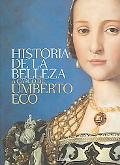

 |

|

The average rating for Historia de la Belleza / The History of Beauty based on 2 reviews is 4.5 stars.
Review # 1 was written on 2013-07-22 00:00:00 Carol Kneller Carol KnellerReading Eco’s study On Beauty feels like visiting a Temple with very many chambers. In each room there are texts. There are also images, many of them too and of good quality and they are all photos of art pieces. During this visit we are accompanied by the talk of a commentator. He comments on the texts only. Not on the images. Each room corresponds to a period in the Quest of Beauty. In this pursuit we can also conceive each space as forming a petal of a different tone and shape, so that by the end of the journey we can see that this Temple has the appearance of a multi-faceted flower. And a beautiful flower it is. In the search for Beauty along Western history many questions have been raised. Where does Beauty originate? Is it in the things? And therefore is it made by man, or is it in Nature and made by god? If a god creates beauty, then what is this god? A concept, like Goodness? Or is it a being? If so, then what was his purpose? Or could man create it not in the things but out of the things? Who is this man (mostly man, sometimes woman) and what is his nature? Are all men capable of creating Beauty? Or is it only some – those who are endowed with a (divine) capacity, and we can call them ‘artists’? And those are the Artists – the beings who can create a (divine) entity – ‘art’? Or is beauty really created by the subject? Is it in front of you or is it in your eye – the shifting eye of the beholder? Can Beauty be measured? Indeed, is it proportion itself? Who measures those proportions? Does it form part of an overall scheme of things, the Harmonic Tutto? Or does it require another quality, such as individuality, and should therefore break the norms and surprise? What is its purpose? To elevate us to a higher, and ethical, or to a sublime realm? And if related to the human, should it be sensual, or smart, or witty? Does it have a gender? Or does it belong to the dominion of a particular gender? To what extent is it relative and needs its own context to shine out. These are many of the questions addressed by Eco as they were formulated by thinkers, and it is his anthology of texts, from Theognis and Plato to critics from the 1950s, going through Plotinus, Suger, Hildegard von Bingen, Dante, Alberti, Gracián, Hume, Kant, Goethe, Diderot, Baudelaire, Foscolo, Burke, Wilde, Pater, Duchamp amongst very many others, that form the backbone of this book. The copious and beautiful images are unconnected illustrations. They are not addressed by Eco nor specifically related to the selected texts. They form a background musing, colouring the excerpts, like in my review. For the book is conceived as an intellectual exercise, an examination of concepts. It is a theoretical flower then, even if the images add a veneer by appealing to a seen and experienced Beauty. Reading the compendium of excerpts, however, is somewhat unsatisfying and one feels that in this Temple one is just looking at the spine of the books stored in those inviting chambers. But they serve as indications for a later trip, without commentator, when one can stay in one of those rooms and think, not contemplate, some of those notions. And as map of the Search of Beauty this book is excellent. |
Review # 2 was written on 2012-10-01 00:00:00 Pierce Dugan Pierce DuganStoria della bellezza = History of beauty, 2nd ed, 2005, Umberto Eco Storia della bellezza (2004, co-edited with Girolamo de Michele – English translation: History of Beauty/On Beauty, 2004). Beauty is in the eye of the beholder, but it also has a lot to do with the beholder's cultural standards. In History of Beauty, renowned author Umberto Eco sets out to demonstrate how every historical era has had its own ideas about eye-appeal. Pages of charts that track archetypes of beauty through the ages ("nude Venus," "nude Adonis," and so forth) may suggest that this book is a historical survey of beautiful people portrayed in art. But History of Beauty is really about the history of philosophical and perceptual notions of perfection and how they have been applied to ideas and objects, as well as to the human body. This survey ranges over such themes as the mathematics of ideal proportions, the problem of representing ugliness, the fascination of the exotic and art for art's sake. Along the way, the text examines the intersection of standards of beauty with Christian belief, notions of the Sublime, the philosophies of Kant and Hegel, and bourgeois culture. More than 300 illustrations trace the history of Western art as it relates, in the broadest sense, to the topic of beauty. تاریخ نخستین خوانش: روز بیست و چهارم ماه ژوئن سال 2012 میلادی تاریخ زیبایی: نظریه های زیبایی در فرهنگهای غربی؛ اثر: اومبرتو اکو؛ ترجمه و گزینش: هما بینا؛ پیشگفتار و تحشیه: جهانگیر شهدادی؛ مشخصات نشر: تهران، فرهنگستان هنر جمهوری اسلامی ایران، موسسه ی تالیف، ترجمه و نشر آثار هنری، 1390، در 230 ص، مصور ، بخشی رنگی، شابک: 9789642320844؛ کتابنامه ص 223، همچنین به صورت زیرنویس، نمایه دارد، موضوع: تاریخ زیبایی شناسی، هنر، فلسفه؛ از ترجمه انگلیسی به فارسی برگردانده شده است - سده 20 م انگار کردم در کلاس درس زیبایی در دانشگاه بنشسته ام، درباره ی سیر نگاههای گفتنی از زیبایی، و سلیقه ها در تاریخ هست. فصلهایی که خود امبرکو اکو نوشته است، کلاس درس است. ا. شربیانی |
CAN'T FIND WHAT YOU'RE LOOKING FOR? CLICK HERE!!!